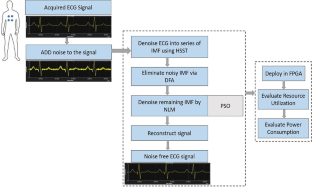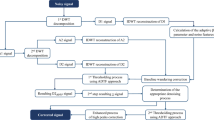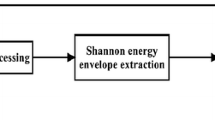Abstract
The alarming mortality rates associated with cardiac abnormalities emphasize the critical need for early and accurate detection of heart disorders to mitigate severe health consequences for patients. Electrocardiograms (ECG) are commonly employed instruments for the examination of cardiac disorders, with a preference for noise-free ECG signals to ensure precise interpretation. However, ECG signal recordings are susceptible to environmental interferences, including patient movement and electrode positioning. This paper introduces a hardware implementation for denoising ECG signals, leveraging a novel method by integrating high-order Synchrosqueezing Transform, Detrended Fluctuation Analysis, and Non-Local-Mean filter optimized by Particle Swarm Optimization (HSST-DFA-PSO-NLM) techniques on Field-Programmable Gate Array (FPGA) platforms. FPGA-based processing units are chosen for their outstanding performance attributes, including high re-programmability, speed, architectural flexibility, and low power consumption, resulting in efficient signal processing. The effectiveness of the designed filtering algorithm is evaluated using key criteria, including Signal-to-Noise Ratio (SNR) and Root Mean Square Error (RMSE) for performance assessment. Additionally, resource utilization metrics such as Look-Up Tables (LUTs), Flip Flops, and DSP Blocks, as well as power consumption measures including dynamic power and static or leakage power, are analysed across various FPGA boards (Virtex and Zedboards) utilizing the VIVADO environment. Comparative analyses are conducted to identify the most suitable FPGA board for implementation, highlighting the superior performance of the proposed design. Remarkably, the proposed denoising solution gives excellent SNR of 29.56, 29.68, and 28.86 by denoising various ECG noises. The RMSE attained by the model is also less than 0.05. This research advances the field of cardiac disorder detection by providing a reliable and efficient FPGA-based solution for ECG signal denoising, thereby enhancing the accuracy of early diagnosis and treatment.




Similar content being viewed by others
Data availability
No datasets were generated or analysed during the current study.
References
Joseph, P., Kutty, V. R., Mohan, V., Kumar, R., Mony, P., Vijayakumar, K., Islam, S., et al. (2022). Cardiovascular disease, mortality, and their associations with modifiable risk factors in a multi-national South Asia cohort: A PURE substudy. European Heart Journal, 43(30), 2831–2840.
Stracina, T., Ronzhina, M., Redina, R., & Marie Novakova. (2022). Golden standard or obsolete method? Review of ECG applications in clinical and experimental context. Frontiers in Physiology, 13, 867033.
Park, J., Cho, H., Balan, R. K., & JeongGil, K. (2020). Heartquake: Accurate low-cost non-invasive ecg monitoring using bed-mounted geophones. Proceedings of the ACM on Interactive, Mobile, Wearable and Ubiquitous Technologies4(3), 1–28.
Sundnes, J., Lines, G. T., Cai, X., & Nielsen, B. F. (2007). Kent-Andre Mardal, and Aslak Tveito. Computing the electrical activity in the heart. 1. Springer Science & Business Media.
Wasilewski, J., & Poloński, L. (2011). An introduction to ECG interpretation. ECG signal processing, classification and interpretation: A comprehensive framework of computational intelligence (pp. 1–20). Springer London.
Jagatap, P. S., Rupali, R., & Jagtap (2014). Electrocardiogram (ECG) Signal Analysis and feature extraction: A Survey. International Journal of Computer Sciences and Engineering, 2, 1–3.
Atrisandi, A. D., Adiprawita, W., Mengko, T. L. R., & Yuan-Hsiang, L. (2015). Noise and artifact reduction based on EEMD algorithm for ECG with muscle noises, electrode motions, and baseline drifts. In 4th International Conference on Instrumentation, Communications, Information Technology, and Biomedical Engineering (ICICI-BME), pp. 98–102. IEEE, 2015.
Islam, M., Kafiul, A., Rastegarnia, & Saeid Sanei. (2021). and. Signal artifacts and techniques for artifacts and noise removal. Signal Processing Techniques for Computational Health Informatics : 23–79.
Pashko, A., Krak, I., Stelia, O., & Wojcik, W. (2022). Baseline wander correction of the electrocardiogram signals for effective preprocessing. In Lecture Notes in Computational Intelligence and Decision Making: 2021 International Scientific Conference Intellectual Systems of Decision-making and Problems of Computational Intelligence, Proceedings, pp. 507–518. Springer International Publishing.
Patel, V., & Shah, A. (2022). Denoising electrocardiogram signals using multiband filter and its implementation on FPGA. Serbian Journal of Electrical Engineering, 19(2), 115–128.
Kumar, A., Kumar, M., & Rama, S. (2022). Komaragiri. FPGA implementation of combined ECG signal denoising, peak detection technique for cardiac pacemaker systems. High performance and power efficient electrocardiogram detectors (pp. 111–129). Springer Nature Singapore.
Kalapothas, S., Flamis, G., & Kitsos, P. (2022). Efficient edge-AI application deployment for FPGAs. Information13(6), 279.
Mourad, N. (2022). ECG denoising based on successive local filtering. Biomedical Signal Processing and Control, 73, 103431.
Wang, X., Chen, B., Zeng, M., Wang, Y., Liu, H., Liu, R., Tian, L., & Lu, X. (2022). An ECG signal denoising method using conditional generative adversarial net. IEEE Journal of Biomedical and Health Informatics, 26(7), 2929–2940.
Rasti-Meymandi, A., & Ghaffari, A. (2022). A deep learning-based framework for ECG signal denoising based on stacked cardiac cycle tensor. Biomedical Signal Processing and Control, 71, 103275.
Elbedwehy, A. N., Awny, M., & El-Mohandes (2022). Ahmed Elnakib, and Mohy Eldin Abou-Elsoud. FPGA-based reservoir computing system for ECG denoising. Microprocessors and Microsystems, 91, 104549.
Nayak, S., Nayak, M., Matri, S., & Kanta Prasad Sharma. (2023). Synthesis and analysis of digital IIR filters for denoising ECG signal on FPGA. Evolving Networking Technologies: Developments and Future Directions : 189–210.
Kumar, A., Ramesh, M., Saisri, U., Vidya Sivani, & Sravani, K. (2023). FPGA implementation of ECG denoising using kaiser window technique. In 3rd International Conference on Pervasive Computing and Social Networking (ICPCSN), pp. 1589–1593. IEEE, 2023.
Gon, A. (2023). and Atin Mukherjee. Design and FPGA implementation of an efficient architecture for noise removal in ECG signals using lifting-based wavelet denoising. In 2023 11th International Symposium on Electronic Systems Devices and Computing (ESDC), 1, 1–6. IEEE.
Ganatra, M. M., & Chandresh, H. (2022). Vithalani. FPGA design of a variable step-size variable tap length denlms filter with hybrid systolic-folding structure and compressor-based booth multiplier for noise reduction in ECG signal. Circuits Systems and Signal Processing, 41(6), 3592–3622.
Costa, M., Moody, G. B., Henry, I., Goldberger, A. L., & PhysioNet (2003). An NIH research resource for complex signals. Journal of Electrocardiology, 36, 139–114.
Thakur, G., & Singh (2010). Synchrosqueezing-based recovery of instantaneous frequency from Nonuniform samples. SIAM J Math Anal, 43, 2078–2095.
Peng, C. K., Buldyrev, S. V., Havlin, S., Simons, M., Stanley, H. E., & Goldberger, A. L. (1994). Mosaic organization of DNA nucleotides. Physical review. E, Statistical physics, plasmas, fluids, and related interdisciplinary topics, 49(2), 1685–1689. https://doi.org/10.1103/physreve.49.1685.
Tracey, B. H., & Miller, E. L. (2012). Nonlocal means denoising of ECG signals. IEEE Transactions on Biomedical Engineering, 59(9), 2383–2386.
Kennedy, J. (2011). Particle swarm optimization. in Encyclopedia of machine learning (pp. 760–766). Springer.
Shami, T. M., Ayman, A., El-Saleh, M., & Alswaitti (2022). Qasem Al-Tashi, Mhd Amen Summakieh, and Seyedali Mirjalili. Particle swarm optimization: A comprehensive survey. Ieee Access : Practical Innovations, Open Solutions, 10, 10031–10061.
Rana, S., Sarwar, M., & Siddiqui, A. S. (2023). and Prashant. Particle swarm optimization: An overview, advancements and hybridization. Optimization Techniques in Engineering: Advances and Applications : 95–113.
Chatterjee, S., Thakur, R. S., & Yadav, R. N. (2020). Lalita Gupta, and Deepak Kumar Raghuvanshi. Review of noise removal techniques in ECG signals. IET Signal Processing, 14(9), 569–590.
Jenkal, W., Mejhoudi, S., Saddik, A., & Latif, R. (2023). Embedded systems in biomedical engineering: Case of ECG signal processing using multicores CPU and FPGA architectures. Smart Embedded Systems and Applications : 103.
Shang, Li, A. S., Kaviani, & Bathala, K. (2002). Dynamic power consumption in Virtex™-II FPGA family. In Proceedings of the 2002 ACM/SIGDA tenth international symposium on Field-programmable gate arrays, pp. 157–164.
Deulkar, A. S., Neelima, R., & Kolhare (2020). Fpga implementation of audio and video processing based on zedboard. In 2020 International Conference on Smart Innovations in Design, Environment, Management, Planning and Computing (ICSIDEMPC), pp. 305–310. IEEE.
Li, H. (2016). and Wenhua Ye. Efficient implementation of FPGA based on Vivado high level synthesis. In 2nd IEEE International Conference on Computer and Communications (ICCC), pp. 2810–2813. IEEE, 2016.
Sinnoor, M. (2022). An ECG denoising method based on hybrid MLTP-EEMD model. International Journal of Intelligent Engineering & Systems, 15, 1.
Lin, H., Liu, R., & Liu, Z. (2023). ECG signal denoising method based on disentangled autoencoder. Electronics12(7), 1606.
An, X., & Stylios, G. K. (2020). Comparison of motion artefact reduction methods and the implementation of adaptive motion artefact reduction in wearable electrocardiogram monitoring. Sensors20(5), 1468.
Funding
The authors declare that no funds, grants, or other support were received during the preparation of this manuscript.
Author information
Authors and Affiliations
Contributions
G.K. and S.P. wrote the main manuscript text .All authors reviewed the manuscript.
Corresponding author
Ethics declarations
Ethics approval and consent to participate
MIT-BIH Noise Stress Test Database and the Arrhythmia Database is used for this research work hence no ethical approval is required.
Competing interests
The authors declare no competing interests.
Additional information
Publisher’s Note
Springer Nature remains neutral with regard to jurisdictional claims in published maps and institutional affiliations.
Rights and permissions
Springer Nature or its licensor (e.g. a society or other partner) holds exclusive rights to this article under a publishing agreement with the author(s) or other rightsholder(s); author self-archiving of the accepted manuscript version of this article is solely governed by the terms of such publishing agreement and applicable law.
About this article
Cite this article
Keerthiga, G., Kumar, S.P. Evaluating FPGA-based denoising techniques for improved signal quality in electrocardiograms. Analog Integr Circ Sig Process (2024). https://doi.org/10.1007/s10470-024-02277-w
Received:
Revised:
Accepted:
Published:
DOI: https://doi.org/10.1007/s10470-024-02277-w




